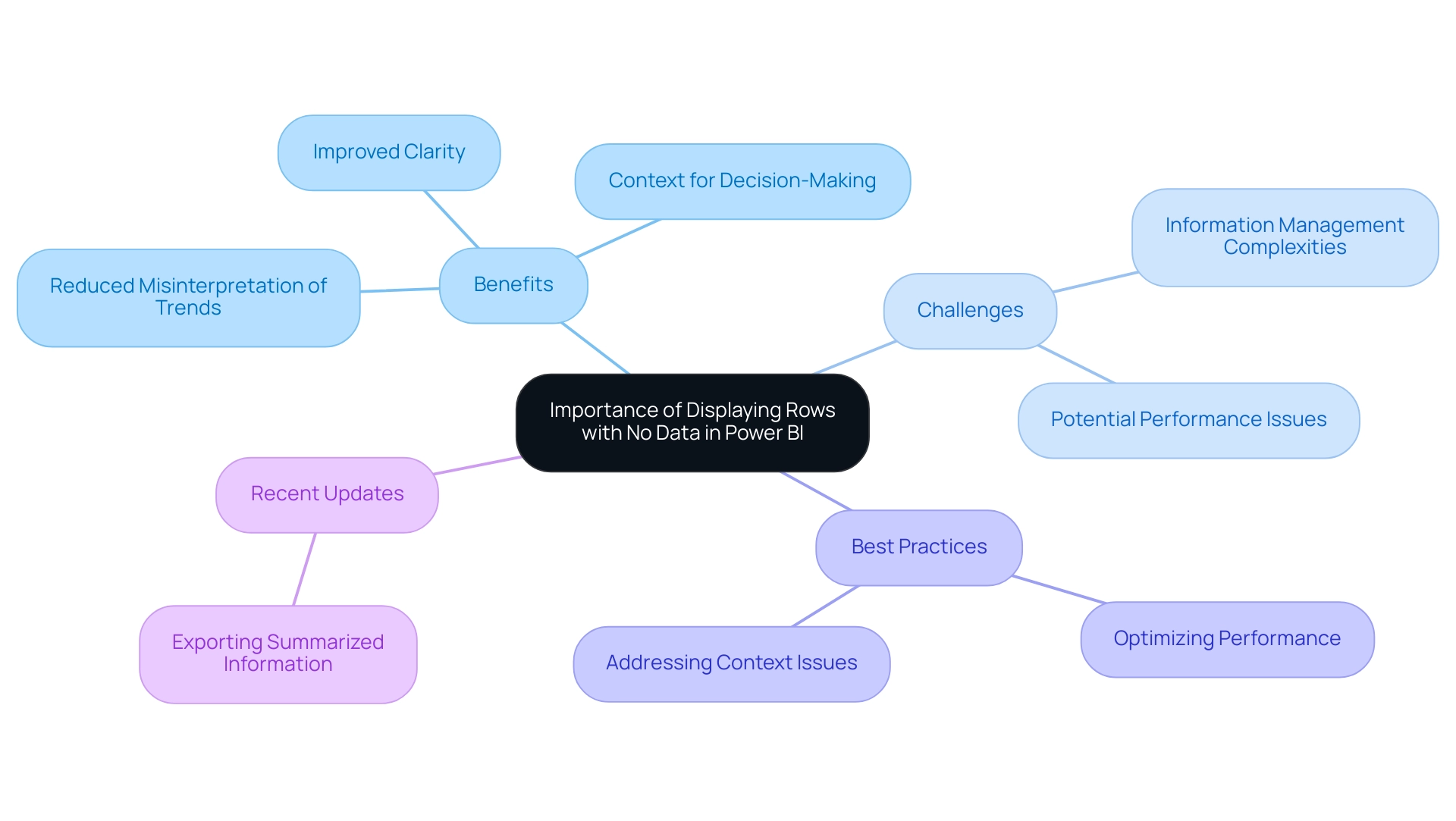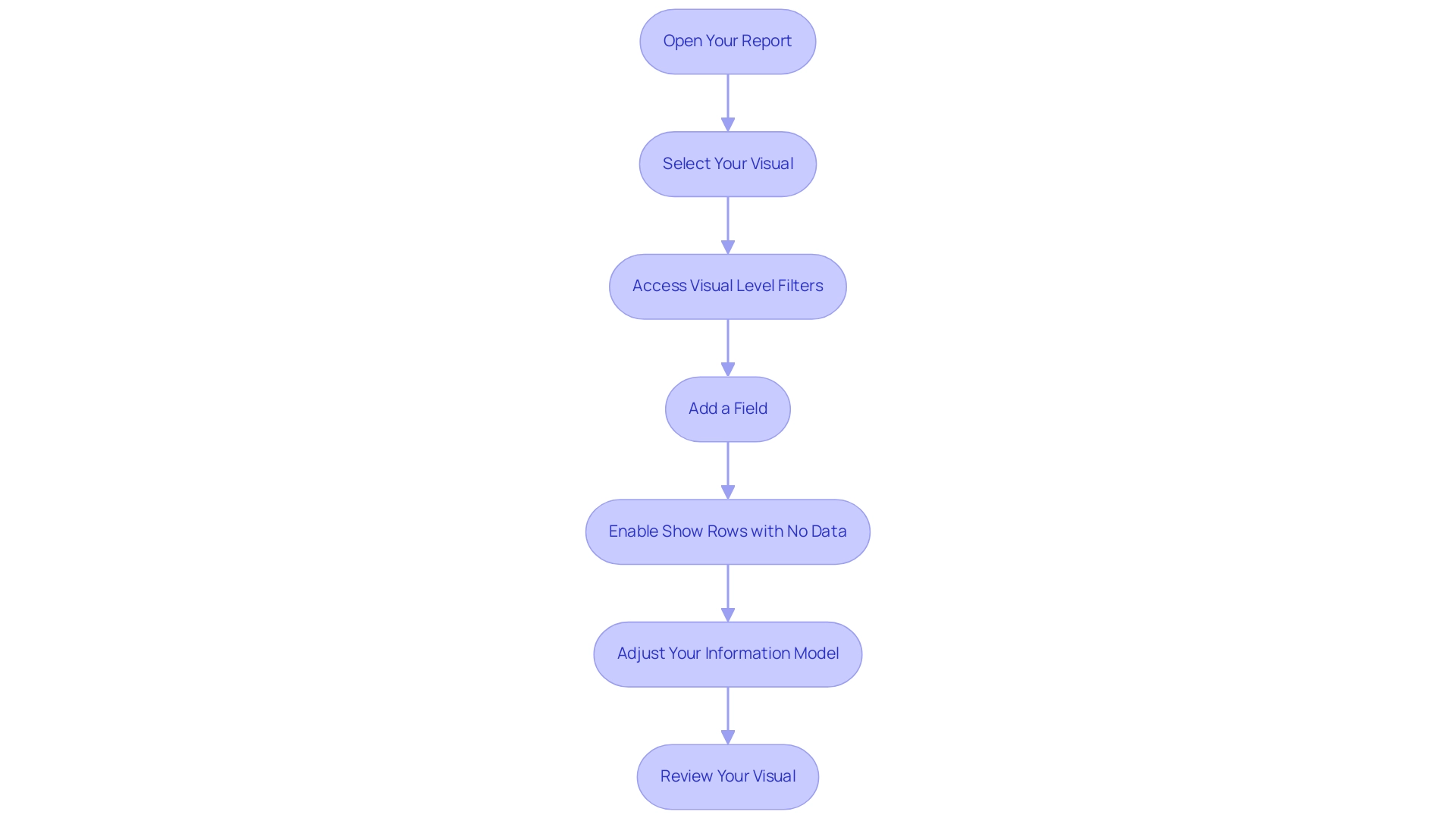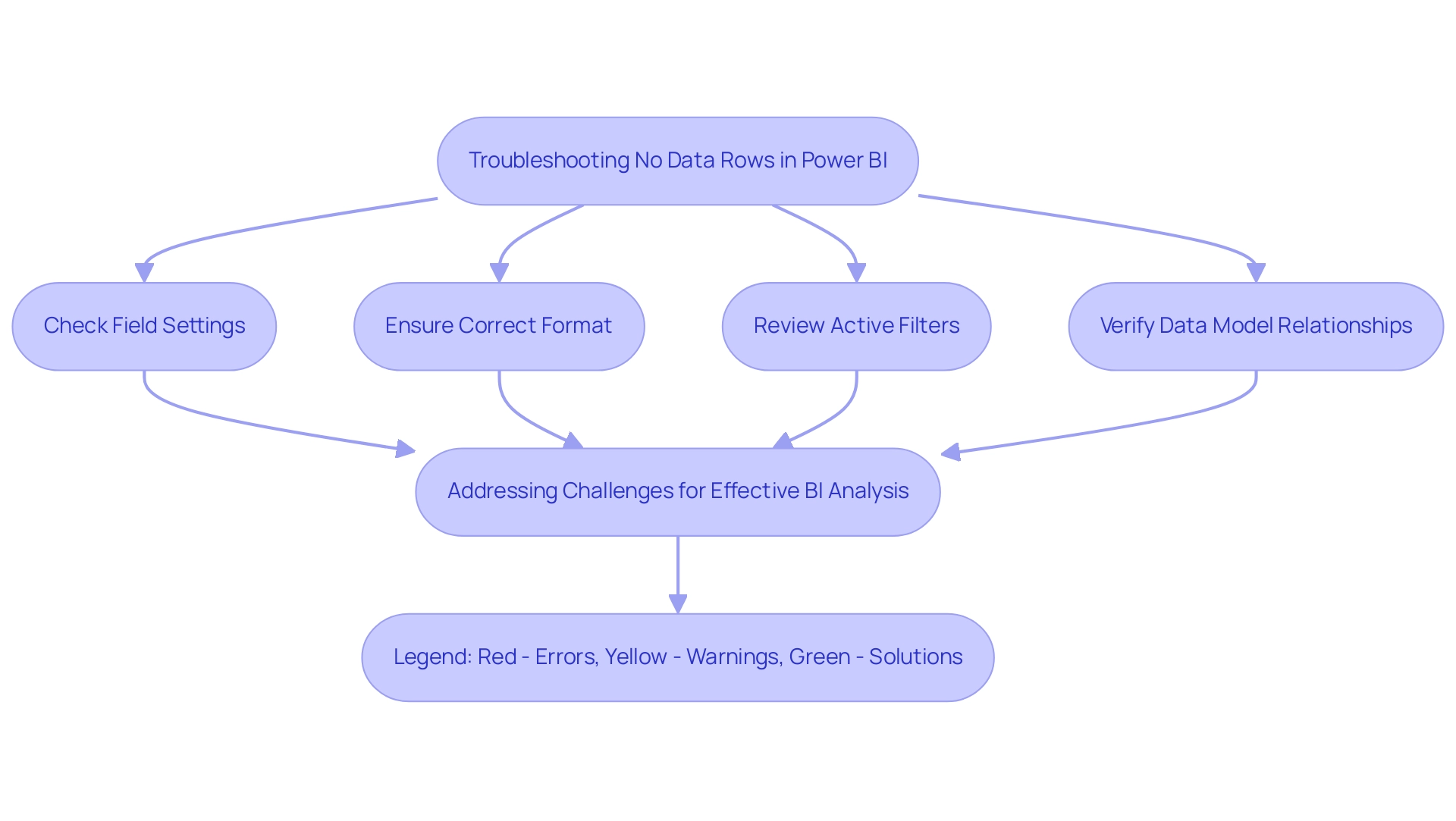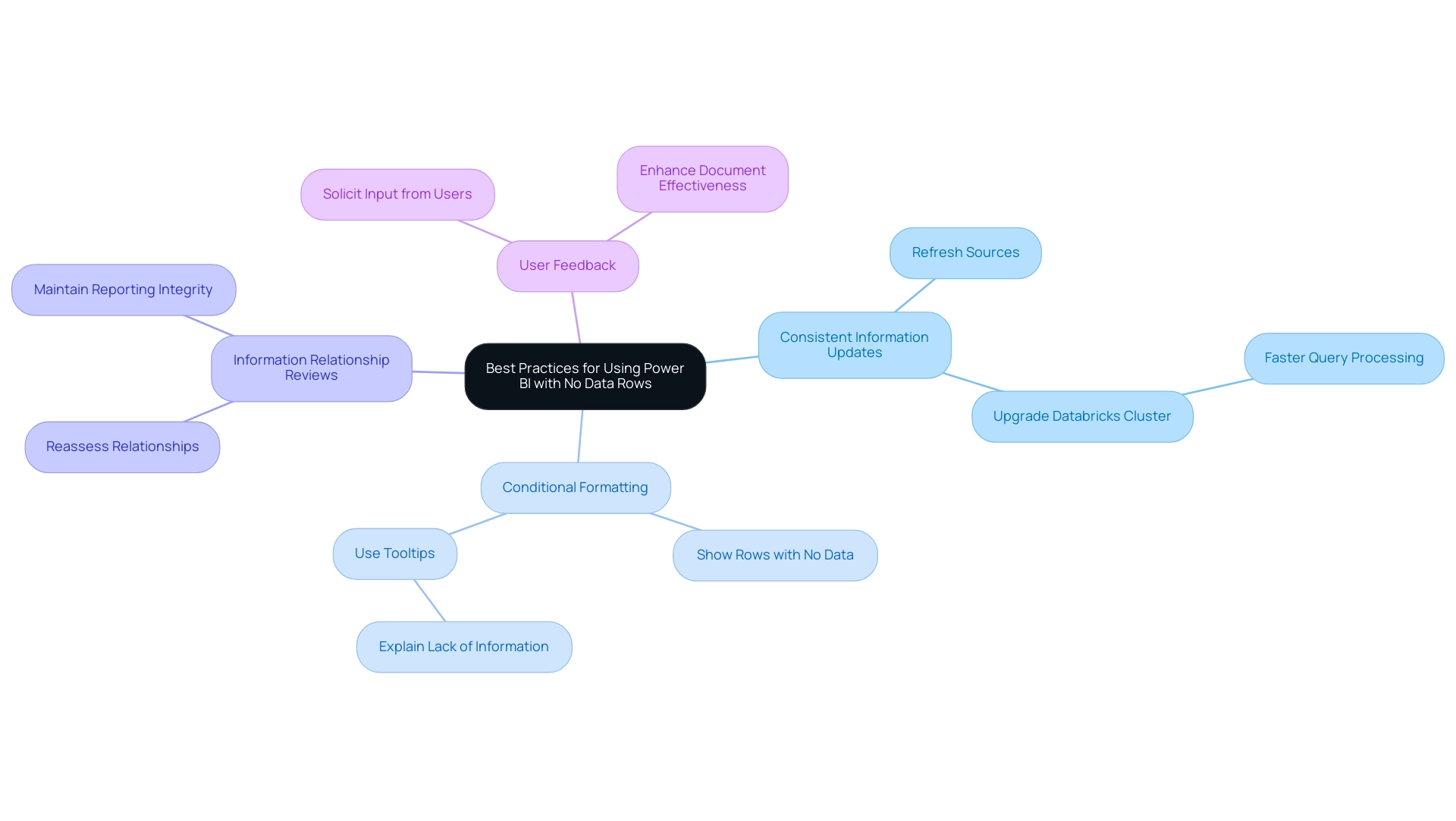Overview:
The article provides a comprehensive guide on how to configure Power BI to display rows with no data, emphasizing its importance for clarity and effective decision-making. It outlines step-by-step instructions for enabling this feature, along with best practices and troubleshooting tips to ensure accurate data representation, thereby enhancing the overall analytical capabilities of Power BI reports.
Introduction
In the realm of data analysis, clarity is paramount, especially when using Power BI to present insights. The ability to display rows with no data is not merely a technical feature; it serves as a fundamental practice that enhances the usability and comprehensiveness of reports. By ensuring that all relevant categories are visible—even those without data—organizations can provide stakeholders with critical context that drives informed decision-making. This approach not only prevents misinterpretation of trends but also highlights areas needing attention, fostering a culture of proactive analysis. As Power BI continues to evolve, mastering the techniques to effectively showcase empty rows will empower users to transform their raw data into actionable insights, ultimately leading to more strategic and impactful outcomes.
Understanding the Importance of Displaying Rows with No Data in Power BI
In Power BI, the feature that allows users to power bi show rows with no data is essential for improving clarity and usability of reports. This functionality ensures that users can view all relevant categories or items, as Power BI shows rows with no data even when information points are absent. For instance, when examining sales information across various regions, representing a region with no sales as zero rather than omitting it entirely provides essential context for stakeholders, guiding them on the next steps in their decision-making process.
This practice reduces the risk of misinterpreting trends and ensures that all areas of interest are taken into account. Furthermore, showing vacant lines reveals deficiencies in information gathering or performance, promoting prompt inquiries and enhancements.
Interestingly, although the size of the information may more than double, the dictionary stays the same size, emphasizing the complexities of information management in BI. A case study examining the impact of grouping columns on information display reveals that the order of columns significantly affects visible combinations, highlighting how Power BI can show rows with no data for accurate analysis. Enabling the ‘power bi show rows with no data’ feature not only provides a more thorough view of the dataset but also improves visibility and supports effective governance strategies, uncovering insights that might otherwise be missed.
As Karan Thapar observes, ‘best practices in BI include optimizing performance and addressing context issues,’ which are crucial when utilizing DAX measures and resolving common problems like formula errors and information quality. Furthermore, recent updates to Power BI, including the ability to export summarized information as if the visual were converted to a table, enhance this capability. These enhancements strengthen the importance of Power BI to show rows with no data and emphasize the necessity for efficient management strategies to simplify documentation creation and enhance data-driven decision-making in your operations.
By converting unprocessed information into practical insights, showing blank lines plays a crucial role in directing stakeholders towards informed actions.

Step-by-Step Guide to Configuring Power BI for No Data Rows
Setting up the tool to show entries with no information is crucial for improving the clarity and thoroughness of your documents, particularly when dealing with frequent issues such as lengthy document creation and information inconsistencies. By following these empowering steps, you can also mitigate the risk of lacking data-driven insights that can leave your business at a competitive disadvantage:
-
Open Your Report: Start by launching Power BI Desktop and accessing the report where you want to showcase entries without data.
-
Select Your Visual: Click on the visual—be it a table or matrix—where you intend to display the empty entries.
-
Access the Visual Level Filters: In the Visualizations pane, find the ‘Filters’ section and ensure that your selected visual is active.
-
Add a Field: Drag the relevant field that corresponds to the rows you wish to display into the ‘Values’ area of the visual.
-
Enable Power BI show rows with no data: In the ‘Values’ section, click the dropdown for the field and select ‘Show items with no information’. This crucial step ensures that Power BI show rows with no data in the visual, even those lacking corresponding information.
-
Adjust Your Information Model: If necessary, confirm that your information model is correctly configured. This may involve establishing relationships between tables to display all relevant items effectively.
-
Review Your Visual: Lastly, check your visual to ensure that sections without information are now shown as intended. Consider formatting these rows differently—such as using a distinct color—to help them stand out from the populated rows.
As mentioned by Power BI specialist Bella Williams, “By mastering these techniques, you’ve equipped yourself with the ability to forecast trends, identify patterns, and gain valuable insights from your information.” This integration of DAX expressions not only improves visibility but also turns your documents into more insightful analytical tools. Additionally, Brian Larson, with his 14 years of experience as a software development consultant, emphasizes the importance of these configurations.
To enhance the effectiveness of your documents, it’s essential to establish a robust governance strategy. This will help maintain consistency across reports, thereby fostering trust in the insights derived from them. The case study titled ‘Statistical Measures in BI‘ further illustrates how using statistical measures can provide greater flexibility and strength in analyzing and visualizing metrics, reinforcing the significance of the steps outlined.

Common Issues and Troubleshooting When Displaying No Data Rows
Displaying rows with no data in Power BI may seem simple, yet users often encounter several common challenges that can hinder their effectiveness in driving data-driven insights:
-
To ensure that Power BI shows rows with no data, it’s essential to confirm that the field settings are arranged to display items without content. Additionally, inspect the relationships within your model to confirm they are correctly established.
-
Incorrect Format: Mismatched types can lead to display issues in BI. Ensure that the data types for your fields are consistent with Power BI’s expectations to avoid complications in visualization.
-
Filters Applied: Active filters on your visuals could inadvertently conceal empty entries. Take the time to review and adjust these filters to ensure they align with your analytical goals.
-
Data Model Relationships: Inaccurate relationships between tables can obstruct the display of certain rows. It’s essential to ensure that your model accurately reflects the necessary relationships for your analysis.
Being proactive about these potential issues allows you to troubleshoot effectively, ensuring that your Power BI reports are both precise and comprehensive. As AZWin95, a new member, insightfully remarked, “Even information exists, information visualization doesn’t appear in my dashboard.” This emphasizes the significance of tackling visualization challenges to improve your analysis efforts.
Furthermore, leveraging RPA solutions like EMMA RPA can help automate the data preparation process, ensuring that data is consistently formatted and relationships are accurately maintained. Automate can also streamline workflows, reducing the time spent on manual adjustments and enhancing the overall efficiency of your reporting.
Additionally, a case study involving the use of #shared in Query revealed that users faced loading issues due to improper configurations. Tackling such prevalent challenges can greatly enhance visibility in BI and boost operational efficiency.
By identifying and addressing these typical challenges, you enable yourself to produce more resilient and insightful BI analyses, thereby fostering growth and innovation within your organization. Don’t forget to take advantage of the upcoming Microsoft Fabric Community Conference scheduled for March 31 – April 2, 2025, in Las Vegas, Nevada. Use code MSCUST for a $150 discount on registration.

Best Practices for Using Power BI with No Data Rows
To optimize the presentation of rows with no information in Power BI and enhance your overall reporting capabilities, implement the following best practices:
-
Consistent Information Updates: Regularly refreshing your sources is crucial to ensuring that reports provide the latest insights. By maintaining information up to date, you can effectively identify trends and gaps, which enhances overall analytical capabilities. Upgrading to a larger Databricks cluster has been shown to significantly improve query processing speeds, a game changer for handling large datasets.
-
Utilize Conditional Formatting in Power BI to show rows with no data, creating a visual distinction between populated and vacant entries. This technique enables users to quickly identify areas that may need further investigation or action, thereby enhancing overall understanding.
Integrate Contextual Details: Enhance your documents by adding tooltips or notes that explain the lack of information in specific entries. Providing context aids interpretation and supports better decision-making by reducing ambiguity. -
Conduct Regular Information Relationship Reviews: As your sources evolve, it’s essential to reassess the relationships within your model. Regular reviews ensure that your reporting remains accurate and relevant, maintaining the integrity of the insights generated. Remember, the 1 million row limit can be exceeded in Premium capacities, which might affect your reporting capabilities.
-
Encourage User Feedback: Actively solicit input from users regarding the effect of how Power BI shows rows with no data influences their understanding and decision-making processes. Utilizing this feedback fosters user engagement and enhances the overall effectiveness of your documents. A practical example of maintaining datasets current is illustrated in the case study on Data Refresh via OneDrive and SharePoint, where linking BI directly to saved files enables hourly updates, thereby enhancing effectiveness.
By following these best practices, you can greatly enhance the clarity and usability of your BI analysis, ensuring stakeholders possess the necessary information to make informed choices. Furthermore, think about using our 3-Day BI Sprint to swiftly generate professionally crafted documents and employ our General Management App for thorough administration and intelligent evaluations. This approach not only enhances report functionality but also supports strategic initiatives within your organization, showcasing the true power of Business Intelligence in driving growth.
Book a free consultation to learn more about how our Power BI services can transform your data reporting.

Conclusion
Displaying rows with no data in Power BI is not just a minor enhancement; it is a strategic approach that significantly improves the clarity and usability of reports. By ensuring that all relevant categories are visible—even those without data—stakeholders gain essential context that informs their decision-making processes. This practice mitigates the risk of misinterpreting trends and highlights areas that require attention, ultimately fostering a culture of proactive analysis.
Implementing the techniques outlined in the article empowers users to leverage Power BI’s full potential. By following the step-by-step guide to configure visuals, addressing common issues, and adhering to best practices, organizations can transform their raw data into actionable insights. The ability to visualize empty rows not only enhances report accuracy but also strengthens the overall data governance strategy, ensuring that reports remain relevant and trustworthy.
As Power BI continues to evolve, mastering the art of displaying no data rows will be a crucial skill for data analysts and decision-makers alike. By embracing these practices, organizations position themselves to make informed decisions based on comprehensive data analysis, driving efficiency and strategic growth. The journey towards effective data presentation is ongoing, but with the right tools and techniques, it is possible to unlock the full value of data in guiding business operations.

